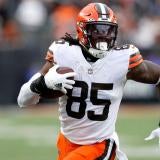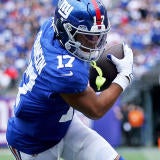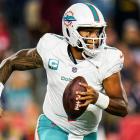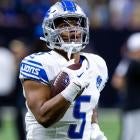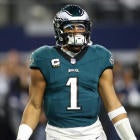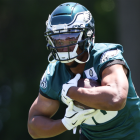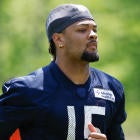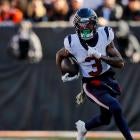If a month ago you told me I'd be invested in the XFL, I wouldn't have believed you. But here I am, interested in this startup league, having witnessed a pretty strong first weekend showing, particularly in terms of the demand for DFS contests at DraftKings and FanDuel.
The popularity of this upstart league is going to peter off as we barrel toward both MLB season and the NFL draft, and what percentage of the opening weekend interest it holds will ultimately determine whether it is a success or failure. For now, signs are promising, and it's captured my attention as well as that of a decent-sized audience.
But there's very little out there in terms of available data. Earlier this week, I wrote my five big-picture takeaways from Week 1, and the most glaring was the lack of running back production. Because timing rules helped to make rush attempts scarce, we'll need to keep a close eye on who is getting the high-value touches (HVT). Those of you who read Stealing Signals during the NFL season will remember my definition of HVT is all running back receptions and touches inside the 10-yard line, which I usually refer to as the green zone.
The XFL's point-after-touchdown rules — no kicking, and the chance to try for one, two or three points from different yardage markers — mean running backs can add additional potential scoring touches, and there is additional data in place about what teams prefer in the high-leverage area of the field. I've tracked and included Week 1 conversion tendencies as well. Big thanks to PFF and XFL.com for the other data. I didn't have full air yards data to discuss, but Cody Main shared some WOPR notes on Twitter.
The last thing I want to mention is while I'm going to go in-depth on the Week 1 usage trends, we should certainly expect many of these to not carry over to Week 2. That's just the nature of a startup league with unsettled depth charts. Some of this will prove not to be predictive at all, but understanding it will give us something to work off.
Week 1
DC Defenders
Snap Notes
RB: Jhurell Pressley: 59%, Donnel Pumphrey: 43%
WR: Malachi Dupre: 77%, Eli Rogers: 69%, Rashad Ross: 59%, Simmie Cobbs: 26%
TE: Khari Lee: 97%
RB high-value touches
Pressley: 2 (receptions unless otherwise listed)
Pumphrey: 1
Pumphrey got the start at running back, but Pressley came in shortly after and was the lead back on the ground. The two virtually split routes (14 to 13 in Pumphrey's favor). Pumphrey is undersized and more of a change-of-pace guy, and because he was the only other back to log significant work, Pressley looks to have one of the more stable lead back roles in the league.
Target share (routes as a percentage of dropbacks)
Rogers: 25% (81%)
Dupre: 14% (84%)
Pumphrey: 11% (45%)
Ross: 7% (68%)
Pressley: 7% (42%)
Cobbs: 7% (16%)
Lee: 4% (61%)
Cardale Jones was very good for DC, completing 62% of his passes for 9.0 yards to attempt while beating Seattle down the field on multiple occasions. He wound up throwing just 26 passes while rushing nine times, though — this may wind up an efficient but lower-volume passing game.
Ross, acquired in a January trade, caught his only two targets for 52 yards and a score. I'd expect his role to increase. Rogers caught all six of his targets and was also targeted on the Defenders' lone conversion passing attempt. Dupre and Lee round out a fairly concentrated passing game.
Conversion data
5 attempts (including one defensive penalty)
1 conversion (Pumphrey run)
1 pass attempt (Rogers target)
One concern for Cardale Jones was he came off the field on four of the Defenders' five conversion attempts (they got two tries after one score due to a defensive penalty). Backup Tyree Jackson handled those packages instead, although Jackson was tackled behind the line of scrimmage on three of those four snaps, either on a read option or straight sack, so we'll see if DC continues to feature him on conversions.
Seattle Dragons
Snap Notes
RB: Kenneth Farrow: 42%, Trey Williams: 32%, Ja'Quan Gardner: 28%
WR: Keenan Reynolds: 94%, Austin Proehl: 70%, Dontez Byrd: 58%, Alonzo Moore: 48%
TE: Colin Jeter: 45% (two others at or above 35%)
RB high-value touches
Kenneth Farrow: 5 (one green zone carry)
Trey Williams: 4
Ja'Quan Gardner: 1 (green zone carry)
Gardner led the backfield in rush attempts, but Farrow and Williams dominated the passing work, each running 16 routes to Gardner's six. Both Gardner and Farrow logged one green zone carry, which neither converted. Williams was the only back to score, on a 13-yard reception. This backfield may not have much value some weeks due to the three-way split, but Farrow and Williams having the edge in HVT puts them more on the Fantasy radar.
Target share (routes as a percentage of dropbacks)
Proehl: 24% (72%)
Reynolds: 17% (95%)
Byrd: 12% (49%)
Williams: 12% (37%)
Farrow: 10% (37%)
Moore: 7% (56%)
Jeter: 5% (44%)
Quarterback Brandon Silvers completed just 21 of 40 passes despite completing eight of nine to the two pass-catching running backs. That means he was just 13 for 31 when targeting wide receivers and tight ends; he was the main culprit in the receiving inefficiency. Silvers is on the injury report for Week 2 so we'll have to await word on whether he's in line to start.
Proehl had a huge day, catching five of 10 targets for 88 yards and two scores. That said, 57 of his yards came on a single catch-and-run touchdown, and yards after the catch isn't a stat to rely on. Reynolds caught just two of seven targets for 5 yards, but his volume was promising. Byrd saw some downfield looks including an end zone shot, but depth receivers don't look like great bets in this offense unless there's a quarterback change.
Conversion data
3 attempts
1 conversion (Reynolds reception)
3 pass attempts (3 Reynolds targets)
Reynolds' volume sees a boost when you consider he was targeted on all three of Seattle's conversion tries, something that might bode well for a future red zone role.
Houston Roughnecks
Snap Notes
RB: James Butler: 71%, Andre Williams: 13%, De'Angelo Henderson: 3% (injured)
WR: Cam Phillips: 100%, Sammie Coates: 71%, Nick Holley: 66% (listed as RB), Kahlil Lewis: 66%, Blake Jackson: 45%, Sam Mobley: 29%, Ryheem Malone: 27%
RB high-value touches
James Butler: 4 (two green zone carries)
Andre Williams: 1
Williams started the game, then was briefly spelled by De'Angelo Henderson before Henderson appeared to get injured. Butler took over the backfield from there, logging the largest snap share of any Week 1 back. Butler ran eight routes to Williams' one, though Houston seems to frequently keep its backs in to pass block in its four-wide sets. Butler looks like a top-tier back for the time being with both Williams and Henderson on the Week 2 injury report. Nick Holley is one more name to mention here — he's listed as a RB at most sites but was essentially a full-time slot wide receiver, which creates some interesting lineup options.
Target share (routes as a percentage of dropbacks)
Coates: 24% (73%)
Phillips: 21% (100%)
Lewis: 13% (65%)
Malone: 13% (35%)
Holley: 11% (68%)
Mobley: 5% (28%)
Butler: 5% (20%)
Jackson: 0% (58%)
Phillip Walker was the star of Week 1, throwing four touchdowns in a pass-happy offense that is clearly the class of the XFL early. He also showed impressive mobility, but only took off four times on the ground compared to 38 pass attempts. It's clear the pass volume will be there in this offense.
The presumed No. 1 receiver, Coates was a disappointment in Week 1, catching just two of nine targets for 26 yards. Several of those incompletions were catchable balls. In terms of snaps, Phillips instead looked like the No. 1, as he didn't miss an offensive play. Phillips caught an early 50-yard score, and added three more catches later. Holley, listed as a running back for Fantasy, ran a high percentage of routes out of the slot, with Lewis operating as the other main slot man. Malone, Mobley and Jackson all look like second-teamers, and got additional run with the game out of hand.
Conversion data
6 attempts (including one defensive penalty)
2 conversions (Walker rush, Lewis reception)
4 pass attempts (2 Lewis targets, 1 target each for Holley, Jackson)
Houston led the league in Week 1 touchdowns, so we got plenty of conversion data. They only tried two rushing plays, and one — and option keeper for Williams — came after a defensive pass interference on Holley on a prior attempt spotted the ball at the 1. Their other conversions featured two targets for Kahlil Lewis, who caught one as well as a short touchdown and looks like a red zone threat out of the slot. Jackson dropped a catchable target on a conversion, his only look of the day. Williams got the other rush attempt early, but was stonewalled.
Los Angeles Roughnecks
Snap Notes
RB: Elijah Hood: 71%, Larry Rose: 23%, DuJuan Harris: 15%
WR: Saeed Blacknall: 77%, Nelson Spruce: 72%, Adonis Jennings: 60%, Jordan Smallwood: 58%
TE: Brandon Barnes: 65%
RB high-value touches
Larry Rose: 1
Rose saw two targets and carried three times, but the untargeted Elijah Hood was the lead back here. Hood saw the first nine running back rush attempts and first hit the sideline after hurdling a defender — we got a sideline interview after that play that made it clear Hood came out of the game due to being winded. Hood was just below Butler for the league's top running back snap share in Week 1, and while he wasn't targeted, he ran 24 routes to Rose's 11 and DuJuan Harris's five. Hood should be expected to see some targets going forward with that type of route involvement — no back in Week 1 ran more routes than his 24.
Target share (routes as a percentage of dropbacks)
Spruce: 35% (87%)
Smallwood: 14% (53%)
Blacknall: 7% (81%)
Jennings: 7% (64%)
Barnes: 7% (53%)
Hood: 0% (45%)
No one dominated a passing game in Week 1 like Spruce, who was extremely productive with 11 catches on 15 targets for 103 yards. Spruce should be considered in the top tier of pass-catchers going forward, if not the overall No. 1 WR.
Smallwood was involved in the red zone, catching an 11-yard touchdown in the second quarter after a first-quarter 2-point conversion reception. Quarterback Charles Kanoff is on the Week 2 injury report and it's not clear who might suit up for Los Angeles, but Josh Johnson still looks like their long-term No. 1 when healthy. That could mean a lower-volume passing game, and Spruce being the only real Fantasy option here most weeks.
Conversion data
2 attempts
1 conversion (Smallwood reception)
2 pass attempts (1 Smallwood target, 1 Blacknall target)
Los Angeles threw on both of their conversion tries, which is a promising sign.
New York Guardians
Snap Notes
RB: Tim Cook: 53%, Darius Victor: 51%
WR: Colby Pearson: 96%, Mekale McKay: 94%, Joe Horn: 78%
TE: Jake Powell: 90%
RB high-value touches
Darius Victor: 3
Tim Cook: 1
Victor and Cook mostly split the work, with Victor seeing more carries over the course of the game but the snaps and routes being close. I compared this backfield to head coach Kevin Gilbride's Giants' backfields before the season so this may be confirmation bias, but Cook looked the part of Brandon Jacobs with his two 1-yard conversions while Victor was the more versatile option — all I could see was Ahmad Bradshaw.
Target share (routes as a percentage of dropbacks)
Horn: 24% (90%)
Powell: 17% (70%)
Pearson: 14% (100%)
McKay: 14% (97%)
Victor: 10% (37%)
Cook: 3% (27%)
In another highly concentrated passing game, Horn dominated targets ahead of the tight end Powell, but I was impressed by Pearson and he has a huge role, running routes on every dropback. McKay was also out in routes for nearly every dropback, and was the presumed No. 1 coming into the season who will certainly get his production in the future. I like the concentration of targets, but each of those four main options seems to have potential to lead the offense in receiving volume any given week, and the jury's still out on Matt McGloin, who was just alright (52% completion percentage, missed some throws) while leading the Guardians to an easy win.
Conversion data
3 attempts
2 conversions (2 Cook rushes)
0 pass attempts
The Guardians went for 1 and ran on all three of their conversion tries, with Cook converting the first two and Victor getting stuffed after the third score.
Tampa Bay Vipers
Snap Notes
RB: De'Veon Smith: 65%, Jacques Patrick: 39%
WR: Daniel Williams: 100%, Jalen Tolliver: 97%, Reece Horn: 69%
TE: Nick Truesdell: 96%
RB high-value touches
De'Veon Smith: 5 (four green zone carries, led Week 1)
Jacques Patrick: 2 (one green zone carry)
Despite the loss and a lot of social media frustration with Tampa Bay quarterback Aaron Murray, the Vipers led the XFL in yards from scrimmage in Week 1 and got inside the 10-yard line on four separate drives, but they settled for just 3 points total on the day. This looks like a clear two-headed backfield led by Smith, who racked up four green zone carries, while Patrick added one.
Tampa Bay ran the ball more effectively when Murray was out of the game for Quinton Flowers, who mostly operated as a read option quarterback before a late 37-yard completion on one of just two pass attempts. Murray is banged up so we might see more of Flowers in Week 2, which should be good for the backs, particularly Smith. Smith also ran 21 routes to Patrick's 14, but how pass-heavy Tampa will be in Week 2 if Flowers plays significant snaps under center is an open question.
Target share (routes as a percentage of dropbacks)
Williams: 25% (100%)
Tolliver: 19% (95%)
Truesdell: 17% (69%)
Horn: 14% (69%)
Patrick: 8% (33%)
Smith: 3% (50%)
Marc Trestman brought Tampa out in a lot of two-TE and two-back (with a fullback) formations, running a pretty old school offense. That limited Horn's snaps as the slot guy, and Williams and Tolliver look like the clear top two receiving weapons in this offense as the outside guys. Williams had the big day in Week 1, but Tolliver was free in the end zone multiple times where Murray either underthrew the pass or, as the broadcast pointed out on one occasion, missed him running unguarded down the field.
I thought Murray played a little better than what the consensus seemed to think, but that's mostly because the consensus seemed to think he was irredeemably terrible. He made some legitimately good throws in the first half (as well as multiple bad ones), but really struggled after the break, and after missing practice time this week is not looking likely to suit up in Seattle. I hope we'll get word whether Flowers might play extended snaps or Taylor Cornelius — who is listed as the team's No. 2 on the depth chart — might step into the Murray passing role while Flowers continues to be limited.
Conversion data
none
St. Louis BattleHawks
Snap Notes
RB: Matt Jones: 64%, Christine Michael: 31%, Keith Ford: 8%
WR: L'Damian Washington: 96%, Alonzo Russell: 80%, De'Mornay Pierson-El: 77%
TE: Marcus Lucas: 73%
RB high-value touches
Christine Michael: 2 (one green zone carry)
Matt Jones was the lead back for St. Louis and the XFL's only 20-carry runner in Week 1, but he didn't record a single high-value touch. He was targeted once, and was far more efficient on the ground (21-85) than Michael, who rushed for 0 yards on seven carries. Lightly-used third-stringer Keith Ford scored the lone rushing touchdown on a 16-yard scamper. Jones did lead the backfield in routes with 13, while Michael had nine and Ford zero.
Target share (routes as a percentage of dropbacks)
Lucas: 26% (78%)
Washington: 19% (100%)
Pierson-El: 15% (84%)
Russell: 15% (72%)
Jones: 4% (41%)
Michael: 4% (28%)
St. Louis was easily the most run-heavy team in Week 1, but Jordan Ta'amu did throw 27 passes, completing 20 for a solid 74% completion percentage. The top four passing options dominated looks, all seeing between 4-6 targets and 3-5 catches, with no one else see multiple passes thrown their way. This won't be a passing game I'll be targeting much going forward, as I tend to shy away from unclear passing offenses that are also low volume.
Conversion data
2 attempts
0 conversion
1 pass (1 Washington target)
Washington saw a target on a fade that he caught out of bounds when St. Louis attempted a 2-point try on their first score. Matt Jones — who I noted above didn't see any high-value touches — did get a handoff on a 1-point attempt late in the game, but didn't convert.
Dallas Renegades
Snap Notes
RB: Cameron Artis-Payne: 52%, Lance Dunbar: 37%, Austin Walter: 24%, Marquis Young: 23%
WR: Jeff Badet: 61%, Flynn Nagel: 56%, Jerrod Heard: 42%, Jazz Ferguson: 40%, Freddie Martino: 37%
TE: Donald Parham: 60%, Sean Price: 47%
RB high-value touches
Lance Dunbar: 6 (one green zone catch)
Cameron Artis-Payne: 5 (one green zone carry)
Marquis Young: 5
Austin Walter: 1
As a team, Dallas's 17 high-value touches dwarfed all others in Week 1, but they rotated four backs. Quarterback Philip Nelson checked down frequently, and we can't be sure if Week 2 starter Landry Jones will carry the same high rate of targets for running backs, but this offense features an extreme pass lean and should be fruitful for running backs in PPR, particularly if the playing time is thinned out some. Artis-Payne led with 23 routes, with Dunbar's 15, Walter's 11 and Young's nine rounding out the rotation.
Target share (routes as a percentage of dropbacks)
Parham: 14% (64%)
Nagel: 14% (62%)
Dunbar: 14% (32%)
Young: 11% (19%)
Badet: 9% (64%)
Artis-Payne: 9% (49%)
Price: 9% (38%)
Heard: 7% (51%)
Ferguson: 7% (34%)
Martino: 2% (43%)
Walter: 2% (19%)
Backup quarterback Nelson completed 79% of his passes, but that was largely because he stayed underneath all day. It's not clear whether that was due to St. Louis's defense or Nelson's unwillingness to take shots down the field, but he went 15-for-15 targeting running backs to bolster his 33-for-42 overall line. He also threw 10 passes to his tight ends, and presumed No. 1 receiver Jeff Badet — who is a speedster — was running drag routes all game, catching three of four passes for just 6 yards on underneath looks.
Jones will start Week 2, and because of that Dallas's passing game will be one of my favorite offenses to target. We will hopefully see more verticality, which should be good news for Badet and Nagel, the top two wide receivers in Week 1, as well as potentially Ferguson and Martino. One thing is clear — this team should be expected to pass a lot, and while the offense might look unconcentrated now, there should be plenty of PPR points to go around.
Conversion data
None

